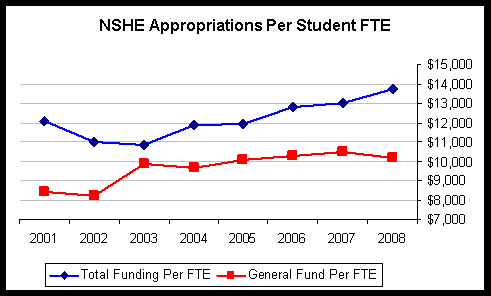NSHE needs to focus on results, not funding
As mentioned before, funding for the Nevada System of Higher Education has grown considerably faster than inflation. But has NSHE seen a comparably strong rise in student population, reducing state funding per student? Some people still feel government should maintain, or even increase, its per-resident or per-pupil funding, regardless of any possibilities of taking advantage of cost-saving ideas.
The reality is that Nevada's universities should be 21st Century capable by now. Meaning: They should be able to take advantage of technology like the virtual classroom that allows them to drastically reduce the cost of educating students. The Virginia Tech Math Department, for example, uses computer modules to instruct students—creating cost savings of up to 75 percent for lower-level math courses.
The following graph looks at NSHE appropriations from the total budget and the general fund (adjusted for inflation to 2008 dollars) and compares them to the Full Time Student Equivalent (FTE). For the 2008-09 school year, we assumed that no students dropped out of college for the spring semester statewide—an assumption that artificially boosts average student FTE for the 2008-09 school year. The result is a rise in per student funding since 2001.

*Source: Nevada System of Higher Education. Figures are adjusted for inflation.
This rapid increase in NSHE appropriations has made the proposed budget cuts appear larger than they really are. Despite the pain, the Nevada System of Higher Education is likely to be no worse off than it was during the last recession—a situation that many businesses in Nevada would envy.
Notwithstanding the increases in per-student funding, NSHE graduation rates have remained dismally poor, with fewer than 50 percent of Nevada students graduating within six years.
Since more spending has not improved graduation rates, Nevada's policymakers need to reexamine the state investment in higher education. The current economic recession provides a great opportunity for policymakers to develop creative and innovative solutions to solve the state's problems. Will they?





